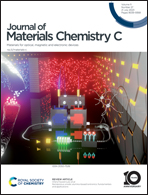Vibronic transitions determined narrowband emission for multi-resonant thermally activated delayed fluorescence emitters†
Abstract
Multi-resonance thermally activated delayed fluorescence (MR-TADF) molecules are an outstanding branch of TADF emitters exhibiting an excellent narrow emission band that is vitally important for the color purity of display applications. Mechanism studies of narrowband emission can be instructive for different types of TADF emitters, especially in the design of the rarely reported red narrowband TADF molecules. In this work, several typical boron-based MR-TADF molecules were studied. Under the framework of Fermi's Golden Rule, vibrationally resolved electronic spectra were investigated and the relationship between the geometry features and the narrowband emission was illustrated. Herein, a MR-TADF molecule is defined as an assembly of a core moiety and surrounding groups. The surrounding groups play an important role in extracting the harmful vibronic transition from the core moiety. A trend was found that the smaller the overlapped area between the populations of the frontier orbitals and the vibrational modes, the narrower the emission band. Based on this correlation, a wideband red-emission D–A type TADF molecule was modified to exhibit a narrowband emission.



 Please wait while we load your content...
Please wait while we load your content...